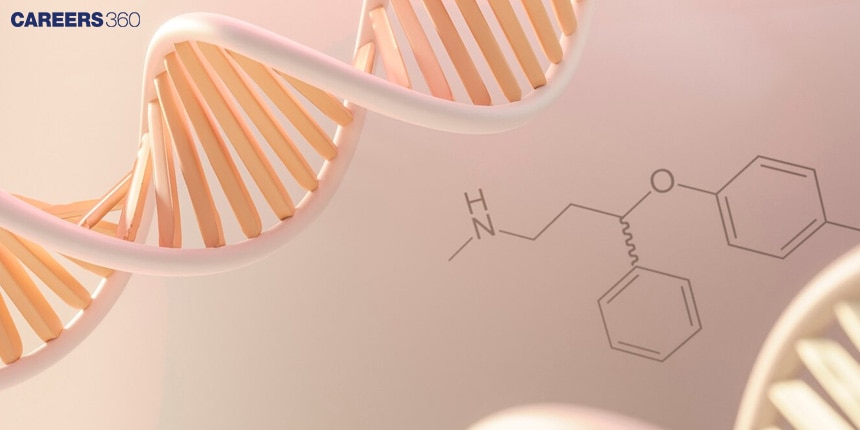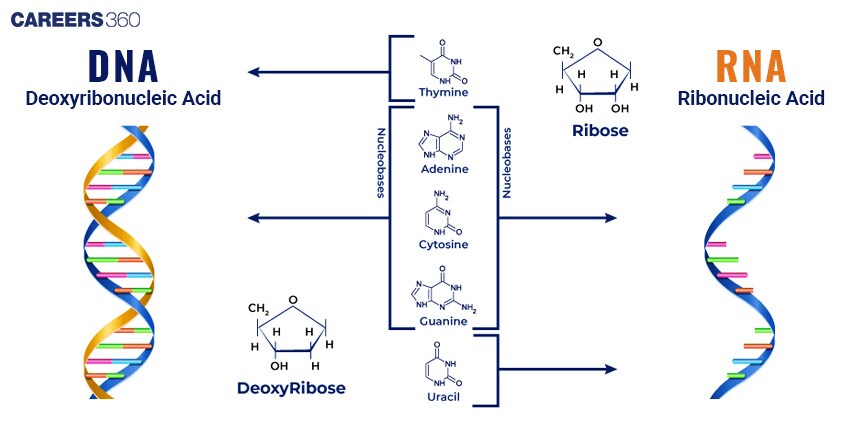Genetic Material- DNA vs RNA: Definition & Function
Genetic material definition: Genetic Material refers to molecules that store and transmit hereditary information in living organisms. DNA and RNA are the two main types of genetic material, with DNA serving as the primary information molecule and RNA playing a role in protein synthesis. Both are made of nucleotides, DNA is double-stranded and stable, whereas RNA is single-stranded. In this article, genetic material, DNA, RNA, and DNA vs RNA are discussed. Genetic Material: DNA vs RNA is a topic of the chapter Molecular Basis of Inheritance in Biology.
NEET 2025: Mock Test Series | Syllabus | High Scoring Topics | PYQs
NEET Important PYQ's Subject wise: Physics | Chemistry | Biology
New: Meet Careers360 B.Tech/NEET Experts in your City | Book your Seat now
- What is Genetic Material?
- DNA as Genetic Material
- RNA as Genetic Material
- Key Differences between DNA and RNA

What is Genetic Material?
Genetic material is the basic foundation of biological components, or it stores, transmits and carries out the level of genetic information or the pathways that pave the way for growth, development and survival. In biological systems, genetic material is present in two basic forms: Deoxyribonucleic Acid (DNA) and Ribonucleic Acid (RNA).
DNA as Genetic Material
Deoxyribonucleic Acid is the full form of DNA. It is the genetic blueprint for the development and functioning of all living things. In 1953, James Watson and Francis Crick described the double-helix structure of DNA.
DNA stands for Deoxyribonucleic acid, a long double-helix molecule composed of nucleotides. A nucleotide is made of a phosphate group, a deoxyribose sugar (forming the sides of the ladder), and one of four nitrogenous bases: adenine (A), thymine (T), cytosine (C), and guanine (G)—purines paired with pyrimidines. This complementary base pairing and, hence, it is very critical for the processes of DNA replication and repair.
The hydrogen bonds between the bases and the hydrophobic interactions among the stacked bases stabilize the double helix. Two strands of DNA are paired in a manner that allows genetic information to be stored in a relatively small space. This proves the fact that every DNA strand can serve as a template for the formation of a new complementary strand in a manner that conveys genetic information correctly during cell division.
Also Read-
RNA as Genetic Material
Ribonucleic Acid, or RNA, is a single-stranded nucleic acid molecule that also codes, transcribes, regulates, and expresses genes. The only difference is while encoding and translating genes, ribonucleic acid works together with other molecules of the cell to carry out the function of producing proteins.
RNA consists of nucleotides containing a ribose sugar, a phosphate group, and one of four nitrogenous bases: adenine, uracil, cytosine, and guanine. The presence of the hydroxyl group on the ribose sugar makes RNA less stable than DNA. Therefore, it is common for RNAs to be single-stranded and less stable than DNAs.
RNA can be folded to form complex three-dimensional structures and, therefore, can perform many structural and catalytic functions in the cell. The fact that RNA is single-stranded has many consequences, including its ability to form secondary structures like hairpins and loops; these features are crucial for the functioning of RNA in the synthesis and regulation of proteins.
Key Differences between DNA and RNA
Chemical Differences: DNA contains deoxyribose sugar, while RNA has ribose sugar. DNA contains thymine (T) as a base, while RNA contains uracil (U).
Structural Differences: DNA as a double-stranded molecule forms a stable double helix structure, while RNA is mostly single-stranded, though it may fold into diverse 3D forms.
Functional Differences: DNA is, therefore, a substituent of the genetic information an organism possesses- and the taker of this to the next generation. RNA, being an intermediary in the function, does the actual synthesis directly for the protein and other cellular operations.
Diagram: DNA vs RNA
Below is the diagram showing the difference between DNA and RNA

DNA vs RNA
It is one of the important differences and comparisons articles in Biology. The differences between DNA and RNA are given below-
Feature | DNA | RNA |
Sugar | Deoxyribose | Ribose |
Structure | Double-stranded helix | Single-stranded |
Stability | More stable | Less stable |
Bases | Adenine, Thymine, Cytosine, Guanine | Adenine, Uracil, Cytosine, Guanine |
Function | Long-term storage of genetic information | Protein synthesis and other functions |
Also Read-
Frequently Asked Questions (FAQs)
DNA is double-stranded with deoxyribose sugar and thymine, while RNA is single-stranded with ribose sugar and uracil.
RNA transcribes genetic information from DNA (mRNA), translates it into proteins (tRNA), and forms part of the ribosome structure (rRNA).
DNA's double-helix structure and lack of a hydroxyl group on the sugar make it more stable than RNA, which is single-stranded and more prone to degradation.
mRNA carries genetic information, tRNA brings amino acids for protein synthesis, and rRNA forms the core of ribosomes and catalyzes protein synthesis.
DNA provides the genetic blueprint, which is transcribed into mRNA, and then translated into proteins by tRNA and rRNA in the ribosome.
Also Read
29 Nov'24 09:31 AM
19 Nov'24 09:26 AM
18 Nov'24 06:45 PM
18 Nov'24 09:29 AM
18 Nov'24 09:18 AM
18 Nov'24 09:01 AM
18 Nov'24 08:37 AM
16 Nov'24 03:45 PM

